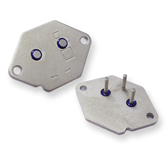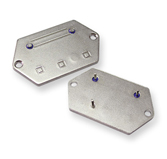|
 |
| |
| Glass to Metal Seal |
- Matched vs. Compression Seals
Glass-to-metal hermetic seals available in industry today are typically one of two types:
To create a matched hermetic seal, housing and glass materials are selected to have similar coefficient of thermal expansion. The strength of a matched seal comes primarily from a chemical bond between the glass and an oxide formed on the metal parts. Matched seals are most often made with Kovar housings and pins, and borosilicate glass.
A compression hermetic seal is made with the housing material thermal expansion rate much higher than that of the glass. Upon solidification of the seal during the manufacturing process, the housing will contract around the glass, applying a desirable compression stress on the glass bead. The strength of the glass-to-metal seal is reinforced mechanically as well as chemically, creating a stronger, more reliable part. Compression seals are often made using steel or stainless steel housings, nickel iron pins, and barium alkali glass.
Application of G.T.M.S.
- vacuum components, sensor or transducer housings, feedthrus for harsh environments, battery headers, and medical implantable devices.
- electrical feedthrus used in a variety of commercial and military applications
- RF/Microwave Hybrid or micro circuit packages
- Housings for optoelectronic Components
- Hermetically sealed packages for the microelectronics industry are hermetic containers which protect the critical microelectronics and components
High Mechanical Strength、 High Temperature Resistance 、
High Precision Dimension 、Chemical Resistance and so on.
|
|
 |
 |
FEED THROUGH
|
FEED THROUGH |
 |
 |
| CRYSTAL STEM |
TO-46 STEM |
 |
 |
| TO-46 STEM |
FEED THROUGH |
 |
 |
| FEED THROUGH |
FEED THROUGH |
 |
 |
| HERMETIC PACKAGE |
FEED THROUGH |
 |
 |
| HERMETIC PACKAGE |
CRYSTAL STEM |
 |
|
| CRYSTAL STEM |
|
▲TOP
|
|
|
|
 |
|
|